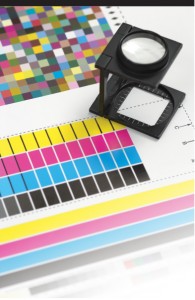This seems to be a common question that arises in our industry, and the answer is… “It really depends!”
First let’s take a look at the differences between of offset and digital printing.
 Offset lithography is the most common form of high volume commercial printing technology. The mechanical process for offset printing is as follows: an image is transferred (offset) to a plate, which is dampened by water, then ink. The ink adheres to the image area, the water to the non-image area. The image is then transferred to a rubber sheet, and from the rubber sheet to the printing surface. Offset printing uses CMYK (four color process) or a combination of Pantone/spot colors.
Offset lithography is the most common form of high volume commercial printing technology. The mechanical process for offset printing is as follows: an image is transferred (offset) to a plate, which is dampened by water, then ink. The ink adheres to the image area, the water to the non-image area. The image is then transferred to a rubber sheet, and from the rubber sheet to the printing surface. Offset printing uses CMYK (four color process) or a combination of Pantone/spot colors.
Many of the mechanical processes for offset are eliminated in digital printing. There are no printing plates required like offset, so digital uses options such as toner or liquid ink that are transferred to the paper quickly and efficiently.
So which makes more sense for a project? Let’s take a closer look at the benefits of each method of printing.
Some of the benefits of offset printing include:
- High quality imagery
- As quantity increases, cost decreases
- Capability of printing on various materials such as different papers, plastic, wood, metal, etc
- Larger sheet sizes on larger presses
Benefits of digital printing are:
- Fast turnaround
- Cost is cheaper for a lesser quantity, due to less expensive setup
- Variable data printing (different names, addresses, codes, etc) is available
- As technology advances, quality has improved
So as you can see, both offset and digital printing has certain advantages. If you have questions on how to proceed with printing, comment below and we will gladly assist.

 A Priority of 2013: Making Your Site Mobile Friendly
A Priority of 2013: Making Your Site Mobile Friendly
